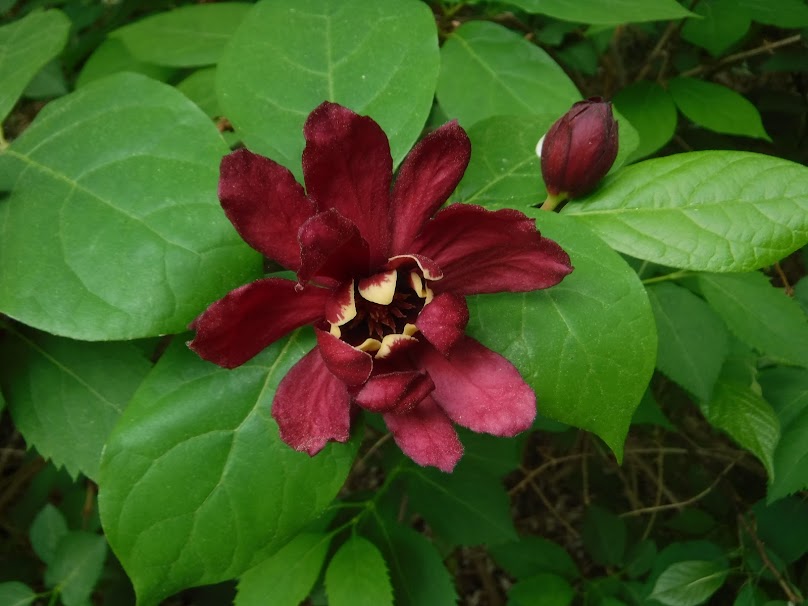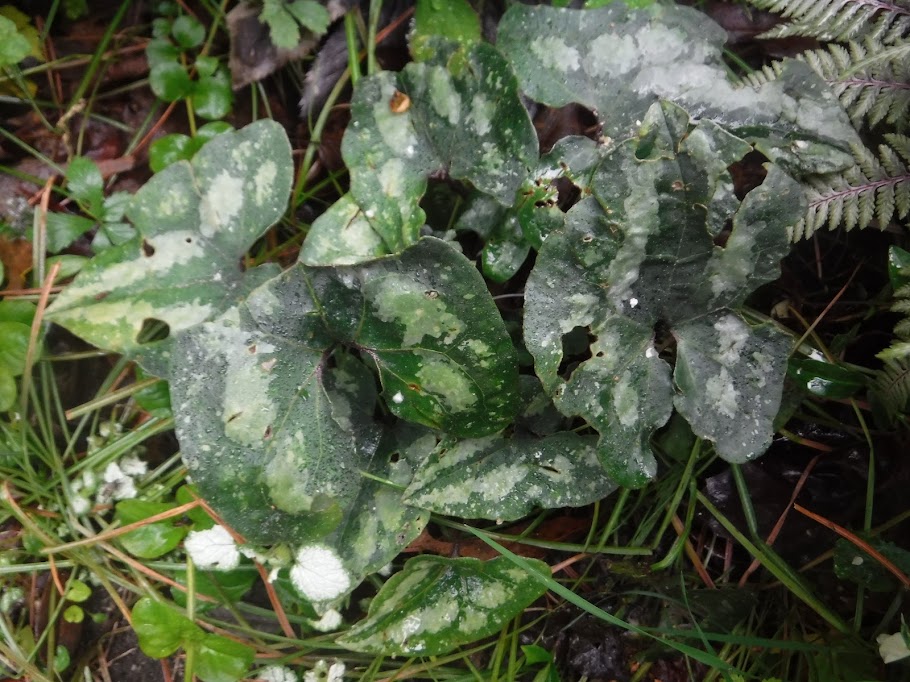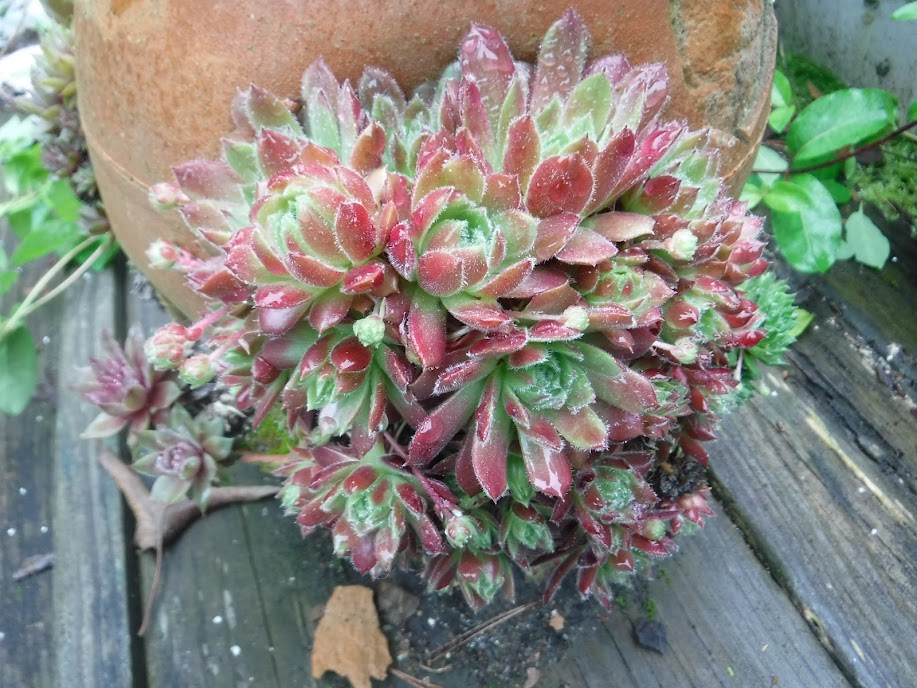Calicanthus 'Hartlage Wine' has larger, more impressive blooms than our southern native, C. florida. But the crushed blooms have none of the strawberry, pineapple, whatever smell of that smaller flowered shrub.
Above and below is Rhododendron 'Purple Passion'. None of the sparkle I see in real life, but I think that comes because light goes into the individual large cells of the flower, reflects back from the further side of the cell, to the eye. Somehow lost to the camera.
For some reason, perhaps because of an exhausting schedule, a good many of the Rhododendrons and Azaleas in the bed in the middle of the lawn just seemed to develop dieing sections. I cut out all the dead parts and the result is a disjointed mess, now requiring attention to rid it of Japanese Honeysuckle and Greenbriar. But the evergreens are coming back. Very little dead, showing up, and, happily, a new chipper, shredder will reduce the pruned items to mulch. Among the Rhododendron 'Iron Clad Red' and Azalea 'Tradition', some 'Blushing Knockout Roses' and a line of Daylilies, in front, is a struggling Azalea called, I believe,'Double Gardenia'. A fine double white I hope increases.
Below is one of the few blooms, so far, from the first Clematis I ever added, here. Clematis 'Ramona' is now on the fence that hides the pool side from view. A mass of many different vines now. More photos of Ramona to come.
Below is the dwarf, unsymetrical clone of the Colorado Blue Spruce.
I believe the proper name to be Picea pungens 'Thume'.
The oriental tree, Styrax japonica 'Emerald Pagoda' and almost finished blooming. Growing next to the barn now toolshed.
And next to that Styrax is the native of our south named Styrax obassia. Amazing that a species from Korea or Japan is one of the close relatives of one in our South Eastern USA. Too many similar examples exist. The Southern groundcover called Galax was once called G. aphylla, since namers thought no known relatives exist, but one was found, recently, in China. So our American species was renamed G. urceolata.
Stachys betonica 'Helene Von Stein' I believe. 'Lamb's Ears' but of special value to me, as this sort has never bloomed for me, and the flower spikes are not so nice. A really dull day for all these photos.
A jungle of cultivars on the fence that hides the pool side from where we park, also competing on the fence that surrounds the pool deck
Clematis 'Ramona' again, on that same fence.
Has always bothered me that someone wanting to sell plants will say 'carefree perennials'. Not the case for me, ever. I do have a simple iron compound that works as a snail or slug repellent, and must find the container and sprinkle some around this Asarum, Ginger, or Hexastylis splendens, as it is succeptable to gnawing by them. The Genus name was changed, recently, from Asarum to Hexastylis.
But, apparently, the European species of Hexastylis or Asarum, H. europeaum, is not bothered by our local slugs, and makes this mass of beautiful, glossy, ground smothering leaves. Almost evergreen, they do look a little messed up by Chrismas.
Here is the huge mass of bloom from the Crossvine, Bignonia capreolata, that has taken over the taller pole, that is part of the fence surrounding the pool deck. As I am sure I said before, this grand vine from our Southern States may be in bloom and completely missed by a hiker or visitor to the woods. Typically, it climbs to the highest spot in some tree and blooms way up out of sight of people.
Up on the pool deck is a Strawberry Jar, old and damaged by frost, with highly successful growth of "Live-Forevers" of various sorts. Various clones of Sempervivium. If I had time, I could replant them into undamaged jars, presently empty.
On a daily basis, each morning I collect what the little cards in the trail cameras catch. Usually too long a video for blogger to handle. But this one worked, and shows a Gray Fox and Raccoon dealing with table scraps. Clearly it did or was raining. The Fox grabs the bone left from a lamb chop and runs off.
The first photo for this period is Calycanthus 'Hartlage Wine'. A hybrid and oriental. But here is the Southern native, with much smaller flowers, Calycanthus florida, the 'Strawberry Shrub', and some clones do smell just like that if the flowers are crushed. The odor varies from clone to clone, in my opinion. C. 'Hartlage Wine' doesn't smell much to me.

Across the lawn the two red sorts of Rhododendron on the property sit side by side, and can be compared. To the left and smaller, to the right, is the old Iron Clad Red. Smaller blooms and the candles of new growth, later, are best shortened by half, each year, as the shrub tends to get leggy. The one with bigger bunches of flowers is 'Francesca', and it does have a more cranberry color and grows tighter.
Rhododendron 'Francesca'.
The lens shaped bed, just outside the bank of windows on the addition, has been weeded twice since Winter. Thankfully, a new wood chipper, shredder is operational, here. I am pleased that time will not go into weeding that bed again, for a while. I left the Mazus repens 'Alba' at the end of the bed, since it is doing so well, even though most bloom is done. I have only to string trim, so it doesn't flow over into the lawn. Strangely, a few stragglers, I allowed to remain, include a normally colored plant. Genetically hard to explain, while, I suppose a seed could revert to the normal blue-violet. I dug out the aggressive 'Bugle Weed' or Ajuga, while, in some circumstances the plant is good. Another recommendation of an old Reader's Digest book for the garden. So many recommended are thugs or overly aggressive, and good for a beginner, I suppose.
The new clumps of Viola odorata were left, as well as some invaders of that species, in the normal violet color. Earlier I showed the newcomers with their candy pink, carmine and yellow colors, and there may be some white, as that sort is common on the property.
By edge of the little pool I planted this amazingly low groundcover called Pratia or Laurentia fluviatilis. But it wandered towards brighter light and is now yards away. To tedious to dig any, I will just buy a plant, if I see it, and put it in the lens shaped rose bed, since there will be little weed competition there, what with the mulch. Like the Mazus, in that bed, Pratia is a New Zealand plant.
Rain caused these to droop over. They are Blushing Knockout and have been in the center circle of the lawn for many years. They, too, show severe Deer browsing, and with this incessant rain, I have struggled to keep repellent spray on them.




























My calycanthus has buds but I am wondering when they will open. It is already getting sort of hot here --- 90 degrees a lot of days.
ReplyDelete